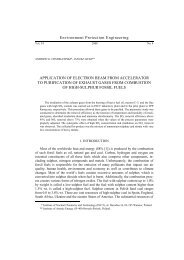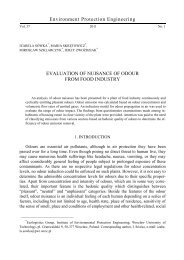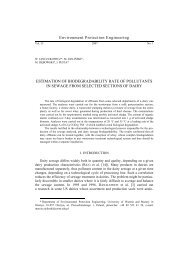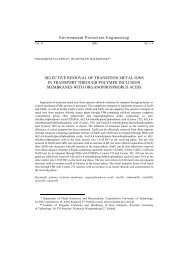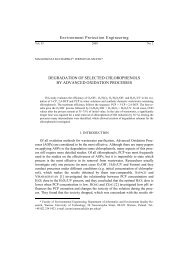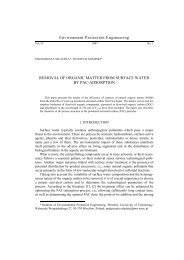Phytotoxkit™ microbiotest used in detecting herbicide residue in soil
Phytotoxkit™ microbiotest used in detecting herbicide residue in soil
Phytotoxkit™ microbiotest used in detecting herbicide residue in soil
Create successful ePaper yourself
Turn your PDF publications into a flip-book with our unique Google optimized e-Paper software.
Environment Protection Eng<strong>in</strong>eer<strong>in</strong>g<br />
Vol. 35 2009 No. 1<br />
TOMASZ SEKUTOWSKI*, JERZY SADOWSKI*<br />
PHYTOTOXKIT TM MICROBIOTEST<br />
USED IN DETECTING HERBICIDE RESIDUE IN SOIL<br />
The studies on the phytotoxic <strong>residue</strong> of <strong>herbicide</strong> active substances <strong>in</strong> the <strong>soil</strong> were conducted<br />
us<strong>in</strong>g a germ<strong>in</strong>ation and early growth <strong>microbiotest</strong> Phytotoxkit TM by Tigret. Three plant species, S<strong>in</strong>apis<br />
alba, Fagopyrum esculentum and Cucumis sativus, were <strong>used</strong> as bio<strong>in</strong>dicators. The <strong>herbicide</strong><br />
active substances tested <strong>in</strong>cluded chlorsulfuron, nicosulfuron, 2,4 DP and dicamba. A plant which responded<br />
most strongly to chlorsulfuron and nicosulfuron was S<strong>in</strong>apis alba. Cucumis sativus responded<br />
most quickly to 2,4 DP <strong>residue</strong>, while Fagopyrum esculentum was most suitable for the detection<br />
of dicamba <strong>residue</strong>.<br />
1. INTRODUCTION<br />
The <strong>in</strong>terest <strong>in</strong> the application of plant bioassays <strong>in</strong> bio<strong>in</strong>dicator test<strong>in</strong>g for the<br />
<strong>residue</strong> of different xenobiotics <strong>in</strong> the <strong>soil</strong> environment has been <strong>in</strong>creas<strong>in</strong>g <strong>in</strong> recent<br />
years [1], [2], [3]. Tests us<strong>in</strong>g fast-germ<strong>in</strong>at<strong>in</strong>g seeds have several very important<br />
advantages, as they are cheap and easy to apply, they do not require expensive laboratory<br />
equipment and these observations are easy to record and <strong>in</strong>terpret as they yield<br />
reproducible results. We also need to stress the fact that some plants are sensitive to<br />
specific or very wide spectra of action of chemicals (<strong>in</strong>clud<strong>in</strong>g also <strong>herbicide</strong>s) [4],<br />
[5], [6].<br />
In ecotoxicology, bioassays are commonly applied methods to determ<strong>in</strong>e the rates<br />
of bioavailable phytotoxic <strong>herbicide</strong> <strong>residue</strong> <strong>in</strong> the <strong>soil</strong> [5], [7]. One of such germ<strong>in</strong>ation<br />
and early growth <strong>microbiotest</strong>s is Phytotoxkit TM by Tigret [8].<br />
The aim of the study was to assess the feasibility of the application of germ<strong>in</strong>at<strong>in</strong>g<br />
seeds of different plant species <strong>in</strong> the determ<strong>in</strong>ation of bioavailable active substance<br />
<strong>residue</strong> of selected <strong>herbicide</strong>s <strong>in</strong> the <strong>soil</strong>.<br />
* Institute of Soil Science and Plant Cultivation, National Research Institute <strong>in</strong> Puławy, Department<br />
of Weed Science and Tillage Systems, Orzechowa 61, 50-540 Wrocław, Poland. E-mail:<br />
t.sekutowski@iung.wroclaw.pl
106<br />
T. SEKUTOWSKI, J. SADOWSKI<br />
2. MATERIAL AND METHODS<br />
Investigations <strong>in</strong>cluded four series of laboratory experiments conducted at<br />
3-month <strong>in</strong>tervals <strong>in</strong> the years 2007–2008. A microassay kit for the determ<strong>in</strong>ation of<br />
phytotoxic <strong>herbicide</strong> <strong>residue</strong> <strong>in</strong> the <strong>soil</strong> based on germ<strong>in</strong>ation and early plant growth,<br />
Phytotoxkit TM by Tigret, was <strong>used</strong> <strong>in</strong> the study. Three plant species are rout<strong>in</strong>ely <strong>used</strong><br />
with this test: Sorghum saccharatum, S<strong>in</strong>apis alba and Lepidium sativum. In order to<br />
provide <strong>in</strong>formation on the behaviour of other plants, Phytotoxkit TM was modified and<br />
two species, i.e. Sorghum saccharatum and Lepidium sativum, were replaced by<br />
Fagopyrum esculentum and Cucumis sativus.<br />
Material for analyses consisted of <strong>soil</strong> samples collected from the 0–20 cm horizon,<br />
from a production field cropped to w<strong>in</strong>ter wheat. This <strong>soil</strong> was characterized by<br />
a slightly acid reaction (pHKCl = 5.5) and low organic carbon content (Corg.= 1.42%). The<br />
<strong>soil</strong> samples collected were dried to the air moisture free level and sieved (mesh size<br />
φ = 2 mm). Sieved <strong>soil</strong> was placed successively on test<strong>in</strong>g plates and soaked with distilled<br />
water until a total water capacity was obta<strong>in</strong>ed. Active substance <strong>residue</strong> was<br />
analyzed for the follow<strong>in</strong>g <strong>herbicide</strong>s: Glean 75 WG (chlorsulfuron), Milagro 040 SC<br />
(nicosulfuron), Am<strong>in</strong>opielik Plus 570 SL (2,4 DP) and Banvel 480 SL (dicamba) with<strong>in</strong><br />
the range of 0.025–1.2 mg/kg. Test<strong>in</strong>g plates were placed <strong>in</strong> an Aporo spray<strong>in</strong>g chamber,<br />
where <strong>herbicide</strong>s were applied <strong>in</strong> amounts ensur<strong>in</strong>g the assumed concentrations of<br />
the active substances <strong>in</strong> <strong>soil</strong> samples. Next plates were covered with filter paper and<br />
seeds of the test plants, i.e. S<strong>in</strong>apis alba, Fagopyrum esculentum and Cucumis sativus,<br />
were sown at a rate of 5 seeds per plate. Test plates were <strong>in</strong>cubated <strong>in</strong> the vertical position<br />
at 25 °C <strong>in</strong> the dark for the period of 5 days. The response of plants to the presence<br />
of chlorsulfuron, nicosulfuron, 2,4 DP and dicamba was assessed on the basis of root<br />
length reduction <strong>in</strong> relation to the control (not sprayed with a <strong>herbicide</strong>). Images were<br />
recorded us<strong>in</strong>g a digital camera, and Image Tools image analysis software was <strong>used</strong> <strong>in</strong><br />
measurements of root length <strong>in</strong> test plants. The results were subjected to the analysis of<br />
variance, compar<strong>in</strong>g the significance of differences at α ≤ 0.05. The <strong>microbiotest</strong> procedure<br />
was described <strong>in</strong> detail <strong>in</strong> the standard procedure [8].<br />
3. RESULTS AND DISCUSSION<br />
Accord<strong>in</strong>g to DEMCZUK et al. [4], SADOWSKI et al. [5], HERNÁNDEZ-SEVILIANO et<br />
al. [9] and KLIMKOWICZ-PAWLAS et al. [10] the selection of an appropriate test plant,<br />
be<strong>in</strong>g <strong>in</strong> an adequate development phase and respond<strong>in</strong>g to the xenobiotic tested, is<br />
the primary and most difficult element affect<strong>in</strong>g the bioassay accuracy.<br />
Figures 1–4 present the results of analyses for Phytotoxkit TM us<strong>in</strong>g the effect of<br />
root length reduction <strong>in</strong> S<strong>in</strong>apis alba, Fagopyrum esculentum and Cucumis sativus<br />
when determ<strong>in</strong><strong>in</strong>g concentrations of <strong>herbicide</strong> active substance <strong>residue</strong> <strong>in</strong> the <strong>soil</strong>.
Phytotoxkit TM <strong>microbiotest</strong> <strong>used</strong> <strong>in</strong> detect<strong>in</strong>g <strong>herbicide</strong> 107<br />
The plant exhibit<strong>in</strong>g the strongest response to chlorsulfuron and nicosulfuron was<br />
S<strong>in</strong>apis alba, followed by Fagopyrum esculentum, while the weakest response was<br />
recorded for Cucumis sativus. The dependence of root length reduction on the concentrations,<br />
rang<strong>in</strong>g from the lowest (0.025 mg/kg) to the highest (1.2 mg/kg), of<br />
chlorsulfuron and nicosulfuron <strong>in</strong> the <strong>soil</strong> showed that the plants selected, i.e. S<strong>in</strong>apis<br />
alba and Fagopyrum esculentum, responded most strongly to these substances. The<br />
detoxication capacity (ED50) for the above mentioned substances <strong>in</strong> these plants was<br />
neutralized at as low concentration as 0.07 mg/kg (chlorsulfuron) and 0.125 mg/kg<br />
(nicosulfuron), while a further <strong>in</strong>crease <strong>in</strong> the concentrations of these substances resulted<br />
<strong>in</strong> a strong reduction of root length (figures 1–2).<br />
Root lenght reduction (%)<br />
100<br />
90<br />
80<br />
70<br />
60<br />
50<br />
40<br />
30<br />
20<br />
10<br />
0<br />
1.2 1 0.75 0.5 0.25 0.125 0.05 0.025 0<br />
Chlorsulfuron concentration <strong>in</strong> the <strong>soil</strong> (mg/kg)<br />
S<strong>in</strong>apis alba<br />
Fagopyrum esculentum<br />
Cucumis sativus<br />
Fig. 1. Effect of chlorsulfuron on plant root length reduction (* – non-significant differences at α ≤ 0.05)<br />
Root lenght reduction (%)<br />
100<br />
90<br />
80<br />
70<br />
60<br />
50<br />
40<br />
30<br />
20<br />
10<br />
0<br />
ED 10<br />
ED 10<br />
1.2 1 0.75 0.5 0.25 0.125 0.05 0.025 0<br />
Nicosulfuron concentration <strong>in</strong> the <strong>soil</strong> (mg/kg)<br />
ED 50<br />
S<strong>in</strong>apis alba<br />
Fagopyrum esculentum<br />
Cucumis sativus<br />
ED 50<br />
Fig. 2. Nicosulfuron effect on plant root length reduction (* – non-significant differences at α ≤ 0.05)
108<br />
T. SEKUTOWSKI, J. SADOWSKI<br />
Similar results were also reported by SADOWSKI et al. [5] <strong>in</strong> their studies on the<br />
detection and behaviour of sulfsulfuron and chlorsulfuron <strong>residue</strong> <strong>in</strong> the <strong>soil</strong> with the<br />
use of a conventional bioassay.<br />
The weakest response to chlorsulfuron and nicosulfuron was found for Cucumis sativus.<br />
In the case of this plant, ED50 for chlorsulfuron and for nicosulfuron was 0.75 mg/kg<br />
and 0.6 mg/kg, respectively (figures 1–2). The weak response of this plant limits its<br />
suitability for the detection of slight concentrations of the substances analyzed. Also<br />
<strong>in</strong> their earlier studies SEKUTOWSKI & SADOWSKI [11] <strong>in</strong>dicated a relatively poor<br />
sensitivity of Cucumis sativus to thifensulfuron-methyl.<br />
For 2,4 DP this gradation is different: Cucumis sativus exhibited the strongest response,<br />
followed by Fagopyrum esculentum, while S<strong>in</strong>apis alba ranked last (figure 3).<br />
Root lenght reduction (%)<br />
100<br />
90<br />
80<br />
70<br />
60<br />
50<br />
40<br />
30<br />
20<br />
10<br />
0<br />
ED 10<br />
1.2 1 0.75 0.5 0.25 0.125 0.05 0.025 0<br />
2,4 DP concentration <strong>in</strong> the <strong>soil</strong> (mg/kg)<br />
Fig. 3. Effect of 2,4 DP on plant root length reduction<br />
(* – non-significant differences at α ≤ 0.05)<br />
S<strong>in</strong>apis alba<br />
Fagopyrum esculentum<br />
Cucumis sativus<br />
Response of Cucumis sativus, Fagopyrum esculentum and S<strong>in</strong>apis alba to<br />
2,4 DP at the lowest concentrations (ED10) was statistically non-significant. With an<br />
<strong>in</strong>crease <strong>in</strong> 2,4 DP concentration the differences between the plants analyzed<br />
changed and at the highest concentration the root length <strong>in</strong> Cucumis sativus was<br />
reduced by 99% and <strong>in</strong> Fagopyrum esculentum and S<strong>in</strong>apis alba, by approx. 80%<br />
(figure 3). It may be clearly observed that the capacity of Cucumis sativus (ED50) to<br />
detoxicate 2,4 DP was neutralized at as low its concentration as 0.125 mg/kg. Such<br />
a strong response of Cucumis sativus makes it possible to analyze even slight <strong>residue</strong><br />
of 2,4 DP <strong>in</strong> the <strong>soil</strong>.<br />
When determ<strong>in</strong><strong>in</strong>g the phytotoxicity thresholds for dicamba it was found that<br />
significant differences <strong>in</strong> root length reduction <strong>in</strong> Cucumis sativus and Fagopyrum<br />
esculentum were observed for concentrations rang<strong>in</strong>g from 0.025 mg/kg to 0.25 mg/kg.<br />
However, the strongest response to this substance was recorded for Fagopyrum<br />
ED 50
Phytotoxkit TM <strong>microbiotest</strong> <strong>used</strong> <strong>in</strong> detect<strong>in</strong>g <strong>herbicide</strong> 109<br />
esculentum. The capacity of Fagopyrum esculentum (ED50) to detoxicate dicamba<br />
was neutralized at as low its concentration as 0.125 mg/kg, while a further <strong>in</strong>crease<br />
<strong>in</strong> the concentration of this substance <strong>in</strong> the <strong>soil</strong> (1.2 mg/kg) ca<strong>used</strong> root length reduction<br />
by 99% (figure 4). Similar results were recorded by SADOWSKI et al. [5]<br />
and WALL & SMITH [12] when compar<strong>in</strong>g the effect of chlorsulfuron, pendimethal<strong>in</strong>,<br />
chlortoluron, MCPA, 2,4 D and 2,4 DP on dry matter reduction <strong>in</strong> selected<br />
test plants.<br />
Root lenght reduction (%)<br />
100<br />
90<br />
80<br />
70<br />
60<br />
50<br />
40<br />
30<br />
20<br />
10<br />
0<br />
ED 10<br />
1.2 1 0.75 0.5 0.25 0.125 0.05 0.025 0<br />
Dicamba concentration <strong>in</strong> the <strong>soil</strong> (mg/kg)<br />
Fig. 4. Effect of dicamba on plant root length reduction<br />
(* – non-significant differences at α ≤ 0.05)<br />
4. CONCLUSIONS<br />
S<strong>in</strong>apis alba<br />
Fagopyrum esculentum<br />
Cucumis sativus<br />
1. S<strong>in</strong>apis alba turned out to be most suitable for detect<strong>in</strong>g chlorsulfuron and nicosulfuron<br />
<strong>residue</strong> <strong>in</strong> the <strong>soil</strong>, followed by Fagopyrum esculentum, while the weakest<br />
response to the substances analyzed was observed <strong>in</strong> Cucumis sativus.<br />
2. In the case of 2,4 DP <strong>residue</strong> <strong>in</strong> the <strong>soil</strong>, Cucumis sativus proved to be the most<br />
sensitive plant. The other phytodetectors, i.e. Fagopyrum esculentum and S<strong>in</strong>apis<br />
alba, responded much weakly to the substance analyzed.<br />
3. Fagopyrum esculentum proved to be most suitable for the detection of dicamba<br />
<strong>residue</strong>. A slightly weaker response was observed for Cucumis sativus, while the<br />
weakest response to this substance was recorded for S<strong>in</strong>apis alba.<br />
4. In the studies with plants <strong>used</strong> as detectors, the selection of an appropriate plant<br />
<strong>in</strong> order to test <strong>herbicide</strong> active substance is of a crucial importance. A sufficiently<br />
sensitive plant makes it possible to conduct analyses at a <strong>residue</strong> concentration of<br />
0.0015 mg/kg <strong>soil</strong>.<br />
ED 50
110<br />
T. SEKUTOWSKI, J. SADOWSKI<br />
REFERENCES<br />
[1] FARGASOVA A., Phytotoxic effects of Cd, Zn, Pb, Cu and Fe on S<strong>in</strong>apis alba L. seedl<strong>in</strong>gs and their<br />
accumulation <strong>in</strong> roots and shoots, Biol. Plant, 2001, 44(3), 471–473.<br />
[2] GONG P., WILKE B.M., STROZZI E., FLEISCHMANN S., Evaluation and early seedl<strong>in</strong>g growth test for<br />
the use <strong>in</strong> the ecotoxicological assessment of <strong>soil</strong>s, Chemosphere, 2001, 44, 491–500.<br />
[3] POWER E.A., BOUMPHREY R.S., International trends <strong>in</strong> bioassay use for effluent management, Ecotoxicology,<br />
2004, 13(5), 377–398.<br />
[4] DEMCZUK A., SACAŁA E., GRZYŚ E., Zmiany aktywności syntazy acetylomleczanowej (ALS) pod<br />
wpływem herbicydu Titus 25 DF u różnych odmian ogórka, Progr. Plant Protect./Post. Ochr. Rośl<strong>in</strong>,<br />
2004, 44(2), 645–647.<br />
[5] SADOWSKI J., ROLA H., KUCHARSKI M., Zastosowanie biotestów do oceny pozostałości herbicydów<br />
w glebie, Prog. Plant Protection/Post. Ochr. Rośl<strong>in</strong>, 2002, 42(1), 152–158.<br />
[6] SMRECZAK B., MALISZEWSKA-KORDYBACH B., Seeds germ<strong>in</strong>ation and root growth of selected plants<br />
<strong>in</strong> PAH contam<strong>in</strong>ated <strong>soil</strong>, Fresenius Environmental Bullet<strong>in</strong>, 2003, 12, 946–949.<br />
[7] GÜNTHER P., PESTEMER W., RAHMAN A., NORDMEYER H., A bioassay technique to study the leach<strong>in</strong>g<br />
behaviour of sulfonylurea <strong>herbicide</strong>s <strong>in</strong> different <strong>soil</strong>s, Weed Res., 1993, 33, 177–185.<br />
[8] PHYTOTOXKIT, Seed germ<strong>in</strong>ation and early growth <strong>microbiotest</strong> with higher plants, Standard<br />
Operational Procedure. Nazareth, 2004, Belgium, MicroBioTest Inc. 24p.<br />
[9] HERNÁNDEZ-SEVILIANO E., CHUECA M.C., ALONSO-PRADOS J.L., GARCIA-BAUDIN J.M., A rapid,<br />
sensitive bioassay method for sulfonylurea <strong>herbicide</strong>s, The BCPC Conference – Weeds, 1999, 3,<br />
711–716.<br />
[10] KLIMKOWICZ-PAWLAS A., KRULOVA J., SMRECZAK B., MALISZEWSKA-KORDYBACH B., Wykorzystanie<br />
testu Phytotoxkit do oceny gleb zanieczyszczonych przez WWA – badania wstępne, Proceed<strong>in</strong>gs of<br />
Scientific Conference on Ecotoxicology <strong>in</strong> the Protection of Soil and Aquatic Environments, IUNG-<br />
PIB, Puławy, 2007, 111–114.<br />
[11] SEKUTOWSKI T., SADOWSKI J., Use of bioassays for assessment of <strong>residue</strong>s level of <strong>herbicide</strong>s active<br />
<strong>in</strong>gredients <strong>in</strong> <strong>soil</strong>, Pestycydy/Pesticides, 2006, (1–2), 59–64.<br />
[12] WALL D.A., SMITH M.A.H., Tolerance of Common Buckwheat (Fagopyrum esculentum) to low rates<br />
of 2,4 D and MCPA, Can. J. Plant Sci., 2000, 80, 407–410.<br />
WYKORZYSTANIE TESTU PHYTOTOXKIT TM<br />
W WYKRYWANIU POZOSTAŁOŚCI HERBICYDÓW W GLEBIE<br />
W badaniach fitotoksycznych pozostałości substancji aktywnych herbicydów w glebie wykorzystano<br />
zestaw do kiełkowania i wczesnego wzrostu rośl<strong>in</strong> Phytotoxkit TM firmy Tigret. Jako bio<strong>in</strong>dykatory stosowano<br />
3 gatunki rośl<strong>in</strong>: S<strong>in</strong>apis alba, Fagopyrum esculentum i Cucumis sativus. Badanymi substancjami<br />
aktywnymi herbicydów były: chlorosulfuron, nikosulfuron, 2,4 DP oraz dikamba. Rośl<strong>in</strong>ą, która najsilniej<br />
reagowała na chlorosulfuron i nikosulfuron, była S<strong>in</strong>apis alba. Na pozostałości 2,4 DP najszybciej reagował<br />
Cucumis sativus, natomiast Fagopyrum esculentum najlepiej nadawał się do wykrywania pozostałości<br />
dikamby.



